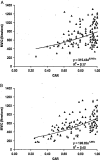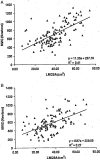Mechanisms underlying quadriceps weakness in knee osteoarthritis
- PMID: 18379202
- PMCID: PMC3573845
- DOI: 10.1249/MSS.0b013e31815ef285
Mechanisms underlying quadriceps weakness in knee osteoarthritis
Abstract
Purpose: To identify determinants of quadriceps weakness among persons with end-stage knee osteoarthritis (OA).
Methods: One-hundred twenty-three individuals (mean age 64.9 +/- 8.5 yr) with Kellgren/Lawrence grade IV knee OA participated. Quadriceps strength (MVIC) and volitional muscle activation (CAR) were measured using a burst superimposition test. Muscle composition (lean muscle cross-sectional area (LMCSA) and fat CSA (FCSA)) were quantified using magnetic resonance imaging. Specific strength (MVIC/LMCSA) was computed. Interlimb differences were analyzed using paired-sample t-tests. Regression analysis was applied to identify determinants of MVIC. An alpha level of 0.05 was adopted.
Results: The OA limb was significantly weaker, had lower CAR, and had smaller LMCSA than the contralateral limb. CAR explained 17% of the variance in the contralateral limb's MVIC compared with 40% in the OA limb. LMCSA explained 41% of the variance in the contralateral limb's MVIC compared with 27% in the OA limb.
Conclusion: Both reduced CAR and LMCSA contribute to muscle weakness in persons with knee OA. Similar to healthy elders, the best predictor of strength in the contralateral, nondiseased limb was largely determined by LMCSA, whereas CAR was found to be the primary determinant of strength in the OA limb. Deficits in CAR may undermine the effectiveness of volitional strengthening programs in targeting quadriceps weakness in the OA population.
Figures



References
-
- Altman R, Asch E, Bloch D, et al. Development of criteria for the classification and reporting of osteoarthritis. Classification of osteoarthritis of the knee. Diagnostic and Therapeutic Criteria Committee of the American Rheumatism Association. Arthritis Rheum. 1986;29:1039–49. - PubMed
-
- Arvidsson I, Eriksson E, Knutsson E, Amér S. Reduction of pain inhibition on voluntary muscle activation by epidural analgesia. Orthopedics. 1986;9:1415–9. - PubMed
-
- Bamman MM, Newcomer BR, Larson-Meyer DE, Weinsier RL, Hunter GR. Evaluation of the strength-size relationship in vivo using various muscle size indices. Med Sci Sports Exerc. 2000;32(7):1307–13. - PubMed
-
- Berth A, Urbach D, Awiszus F. Improvement of voluntary quadriceps muscle activation after total knee arthroplasty. Arch Phys Med Rehabil. 2002;83:1432–6. - PubMed
-
- Binder-Macleod SA, Halden EE, Jungles KA. Effects of stimulation intensity on the physiological responses of human motor units. Med Sci Sports Exerc. 1995;27(4):556–65. - PubMed
Publication types
MeSH terms
Grants and funding
LinkOut - more resources
Full Text Sources
Medical

